Guide to the Principia Map and Table
On the landing page for the map, you will notice there are differently colored circles:

All the circles stand for different propositions (often called "Prop" in the text). These are typically called “starred numbers” because propositions in Principia are numbered “*X.Y” where “X” stands for the chapter and “Y” stands for a number within that chapter. These numbers are always visible on the Principia Map. Note that numbers jump around between chapters, as when *20 is the chapter right after *14. The numbers within chapters also jump around, as when *2.73 is the starred number immediately following *2.69 in the text.
All the circles are either brown, purple, or blue. Brown circles indicate demonstrated propositions (abbreviated “Thm” here to distinguish them from "Prop" in general). Purple circles indicate primitive propositions (abbreviated “Pp”). Blue circles indicate definitions (abbreviated “Df”).
Some of these circles are half brown, purple, or blue, with their other half colored black. This is to distinguish two kinds of demonstrated propositions, two kinds of (non-demonstrated) primitive propositions, and two kinds of definitions.
- Some demonstrated propositions (almost all of them) have a turnstile “⊢” preceding them; an example is *2.08, ⊢. p .⸧ . p (“any proposition implies itself”). Other propositions have no turnstile “⊢” but still have demonstrations in the text; an example is *3.03, which assures that given ⊢. Φp and ⊢. Ψp, we can infer ⊢. Φp . Ψp
- Some primitive propositions have a turnstile “⊢” preceding them like a modern axiom schema would; an example is *1.2, or “⊢. p v p . ⸧ . p”. Other primitive propositions are not preceded by a turnstile; an example is *1.1, or modus ponens (“given ⊢.p and ⊢.p⸧q, infer ⊢.q”), which enables transitions between propositions.
- Some definitions are permanent and apply to all subsequent chapters unless otherwise noted; an example is *1.01, or ~p v p . = . p ⸧ q. Other definitions are temporary and are introduced only for the chapter in which they are introduced; an example is *95.01, which introduces a chapter only used in *95.
In short, wherever you see a circle colored half black and half one of the other three standard colors, pay attention! There is something non-standard occurring in the text.
The big black circles with starred numbers indicate the chapters of Principia. You can mouse over the chapter to see further information about it:
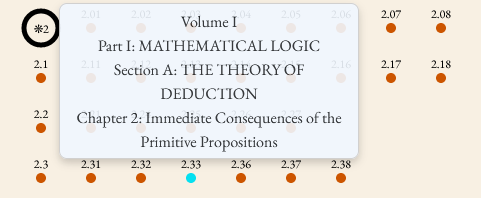
The circles that stand for starred numbers are arranged in a patten according to their number. We use Chapter 1 as an example. In Chapter 1, all starred numbers are numbered *1.Y where Y is some number. If the number of digits in Y is odd, the numbers go down. If the number of digits in Y is even, then the starred numbers go across.
So, every time a digit is added to “Y”, the nodes change which direction they expand in. So we have 1.1, 1.2, 1.3, 1.4, 1.5, 1.6, and 1.7 all in a vertical row:
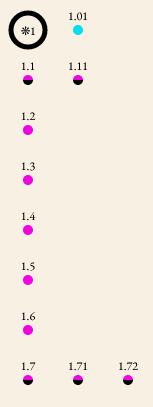
But notice that we also have *1.01, *1.11, *1.71, and *1.72; these go across rather than down because there are two digits after the decimal. So we align *1.7, *1.71, and *1.72 on the same horizontal line. In the case of X.0Zs, we align them with the chapter number itself.
This ordering continues in the above pattern as the decimal numbers increase. The numbering of propositions in Principia also skips around a bit, so sometimes this produces a funny-shape for the chapter map.
In the top-right corner, there is also a search bar allowing you to jump to any starred number or chapter on the map:
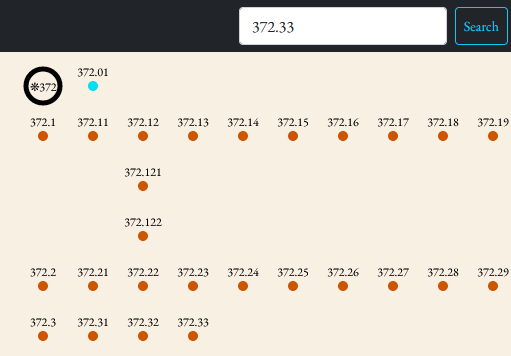
Note that no asterisk should be inclued when searching for a chapter or a number: nothing will happen if an asterisk is included. The search function will just behave as if the number doesn't exist, and in all such cases, it will not jump to anywhere on the map but will remain in whatever place it was previously.
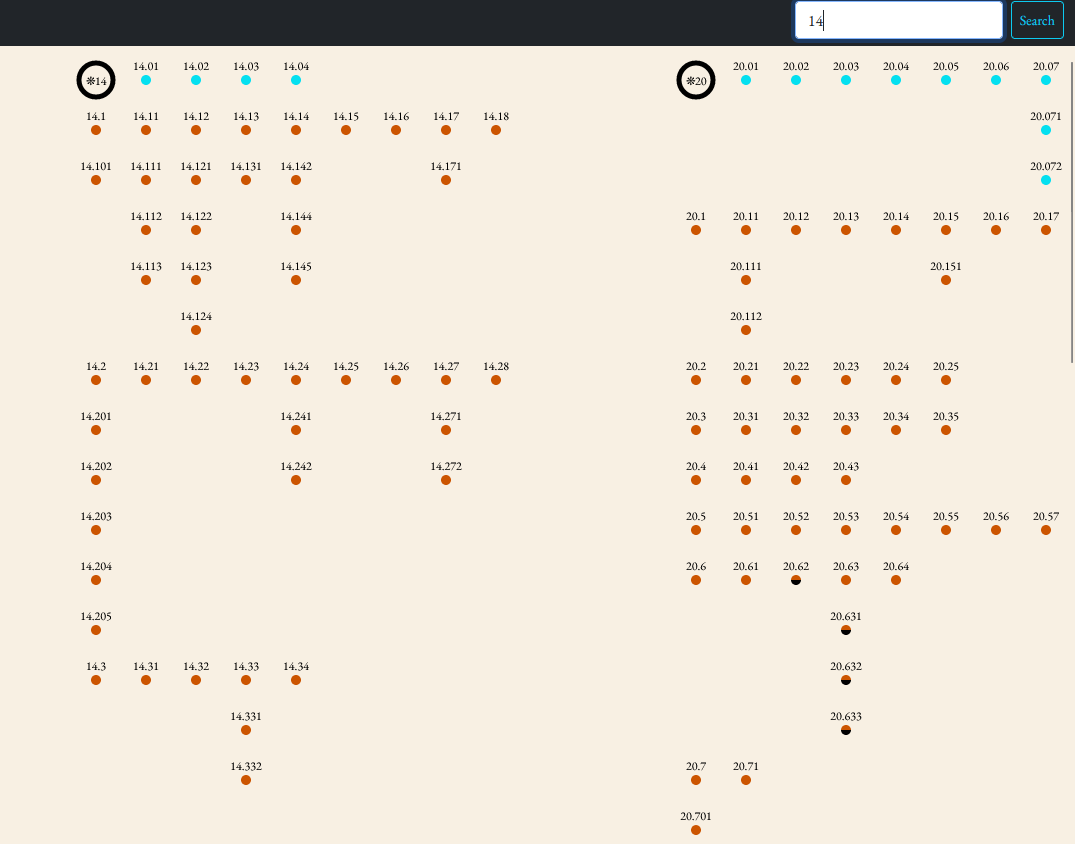
You can scroll from left to right or from right to left on the Principia Map, too. Incidentally, [it takes 11 minutes and 18 seconds to scroll from beginning to end and back again].
Clicking on any starred number on the Principia Map also opens in a new window a mini-map of a starred number. See below.
Guide to the Principia Mini-maps
The Principia Mini-maps show in yellow the starred number that you clicked on. If you click on *2.2, you get the following:
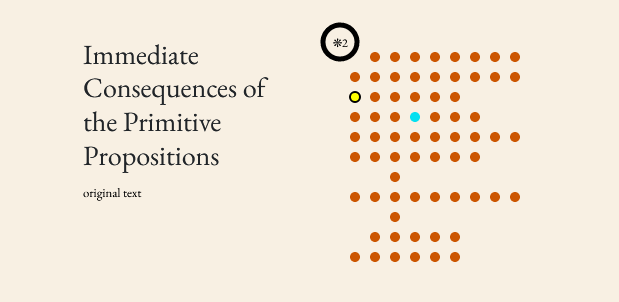
*2.2 is now colored yellow and has a black circle around it. This shows the location of *2.2 in the chapter map. On the left column of the mini-map, all starred numbers cited to demonstrate *2.2 are given with their own mini-maps. There are three distinct starred numbers cited in the demonstration of *2.2, so we have three mini-maps below in the “Its Proof Cites…” column on the left side:
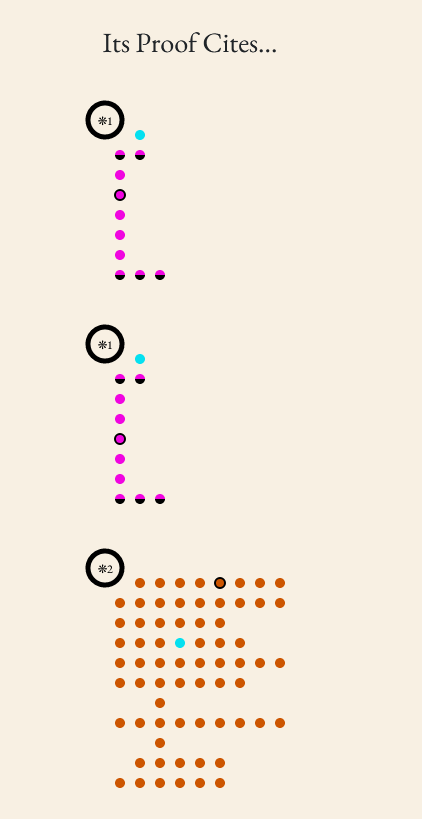
In the mini-maps of starred numbers cited to demonstrate *2.2, a mini-map of Chapter 1 occurs along with a black circle around *1.3. This indicates that *1.3 is cited in the demonstration of *2.2. Since *1.3 is also purple, it is a primitive proposition.
Since *1.4, another primitive proposition, is also cited in the demonstration of *2.2, the mini-map of Chapter 1 occurs twice. But the second time this mini-map appears, *1.4 is circled.
Since *2.05 is cited to prove *2.2, the mini-map of Chapter 2 occurs in the “Its Proof Cites…” column also, but *2.05 is circled instead. Since that starred number is brown, this shows that a previously demonstrated proposition was cited as a lemma in the demonstration of *2.2.
On the right column of the Principia Mini-map of a given starred number, “Cited in Proof of…”, there are similarly mini-maps of all starred numbers whose demonstration cite the starred number you clicked. This gives a visualization of how often a starred number is used. Since *2.1 is cited twelve times in later demonstrations, there are twelve mini-maps in this column:
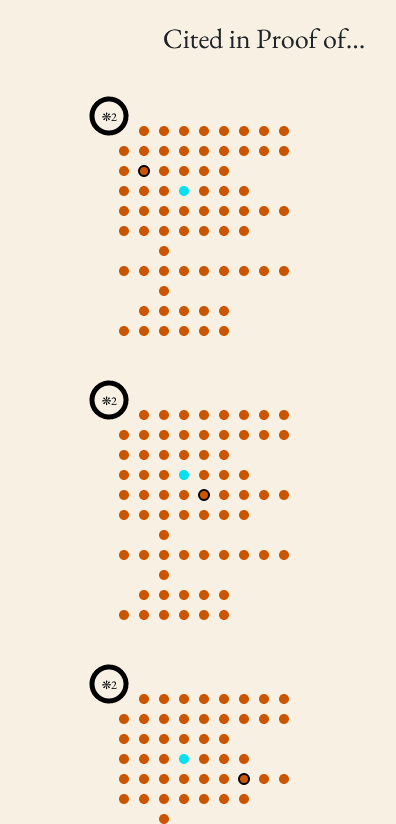
Now *2.2 is cited in the demonstrations of *2.21, *2.45, *2.47, *2.49, *4.43, *4.44, *4.45, *4.77, *10.41, *22.58, *63.107, *120.15. This means we have four mini-maps of Chapter 2 with different starred numbers circled, three mini-maps of Chapter 4 with different starred numbers circled, and one mini-map of Chapter 10, Chapter 22, Chapter 63, and Chapter 120.
Some starred numbers have no demonstration, so their left column is blank. Some starred numbers are never cited later, so their right column is blank. Some starred numbers are cited extremely often – for that reason, if you click *1.11, be wary!
Within a given mini-map page, you can mouse over any circle to see what starred number it has. You can also mouse over chapter numbers to get the same information that was available on the mini-map.
Guide to the Principia Table
We also have the Principia Table, a searchable and exportable database of every starred number and demonstration in Principia. You can search for starred numbers, data about them, and their citation networks (meaning, you can search for where is a starred number used, and you can search for what is used to prove a starred number).
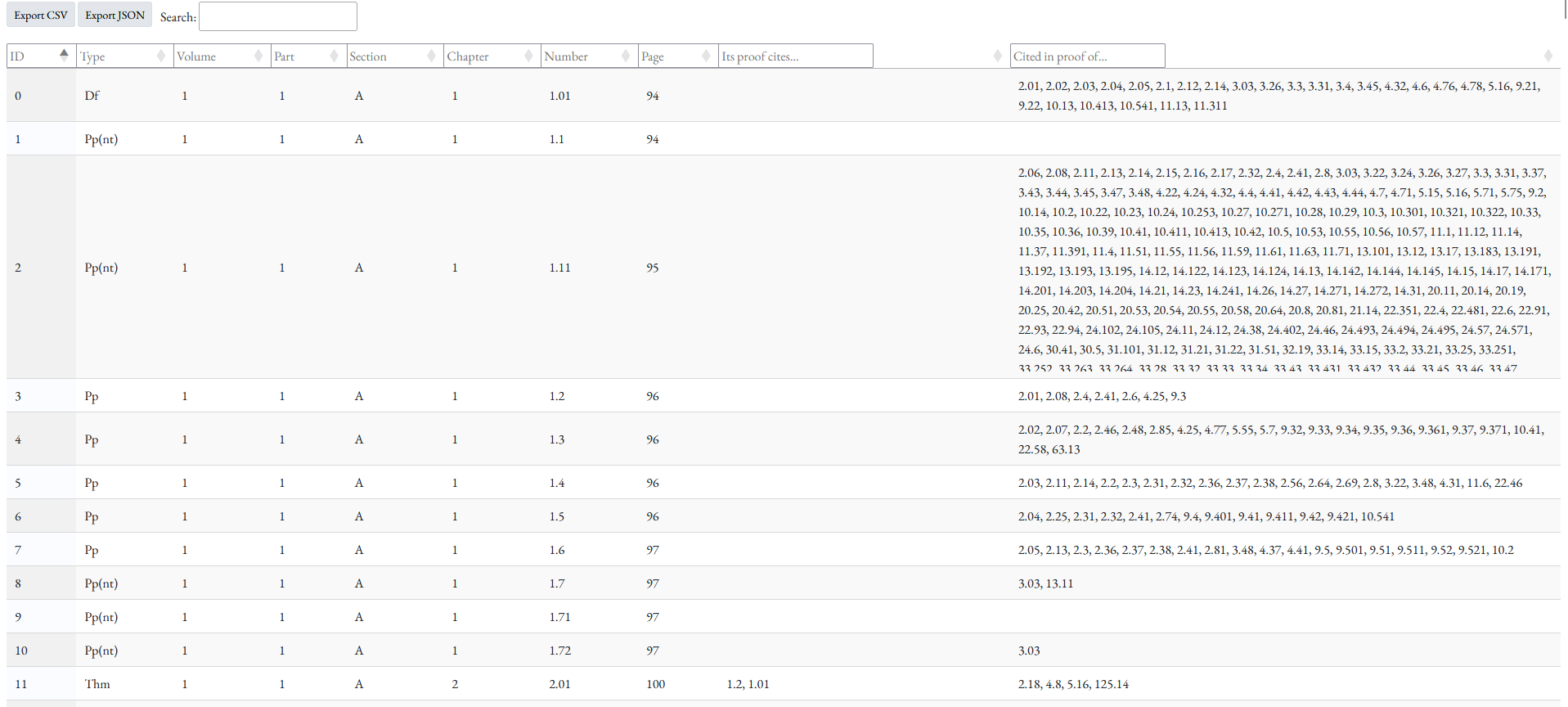
Propositions are sorted into types: “Pp” (or “Pp(nt)”) for primitive propositions (“nt” means “no turnstile”), “Thm” for demonstrated propositions, and “Df” (or “Dft”) for definitions (“Dft” means “temporary definition”).
Every starred number has a unique identification (“ID”) number that is not in the text but is in our Principia database; there are 9,944 starred numbers in Principia (ID numbers begins with “0”).
When you begin typing into one of the bars, it filters out all starred numbers that do not fit the description. For example, you can search for all “Pp” or primitive propositions in Principia:
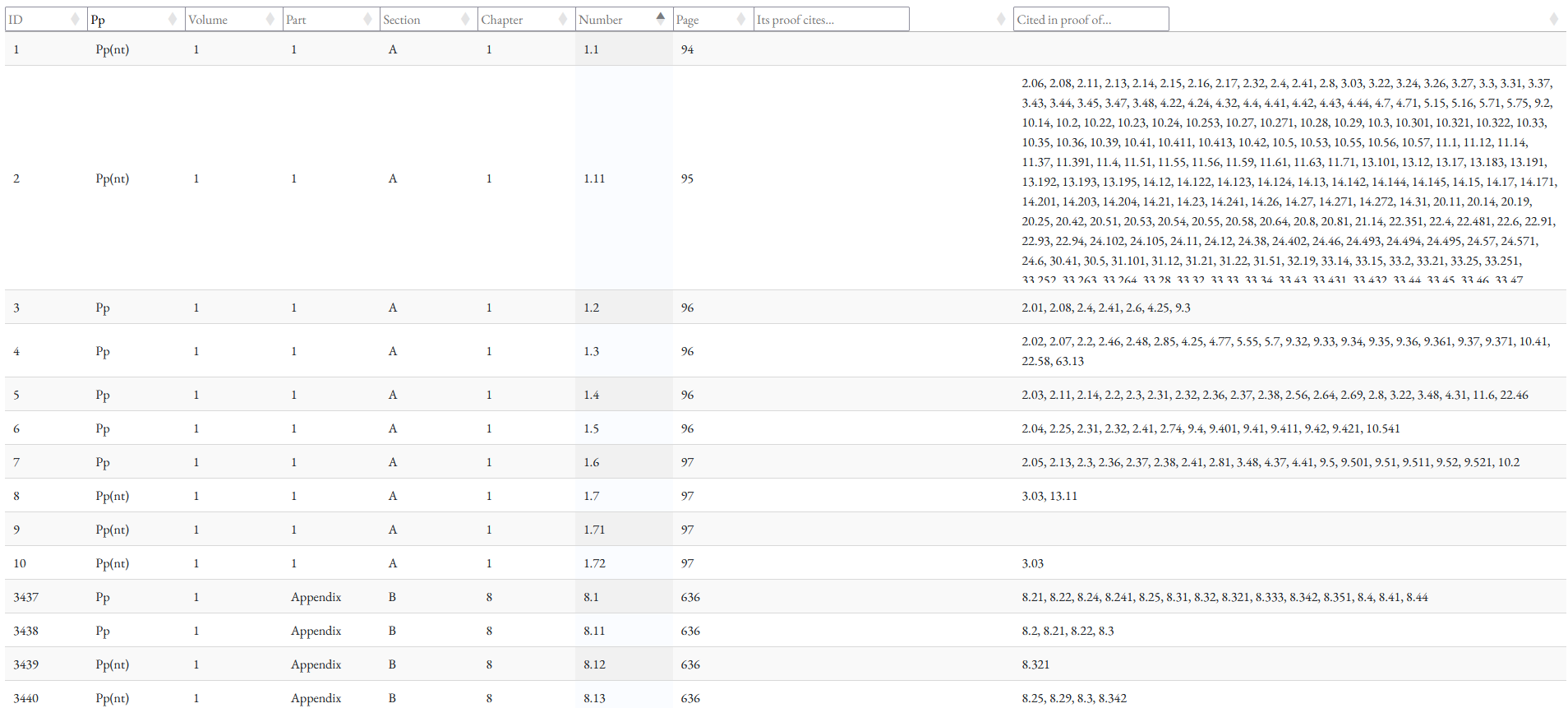
You can also search for all temporary definitions, all starred numbers in a given chapter or part or volume, all starred numbers on a given page, and so on.
On the right side of the table, you will see an “Its proof cites…” column and a “Cited in proof of…” column. The “Its proof cites…” column shows what is cited in a starred number’s demonstration. The “Cited in proof of…” column shows the demonstrations a starred number is cited in.
You can also export the results of your search into a CSV file format or a JSON file format by clicking the buttons at the top left of the screen. For example, putting “9” in the “Chapter” column gives the following:
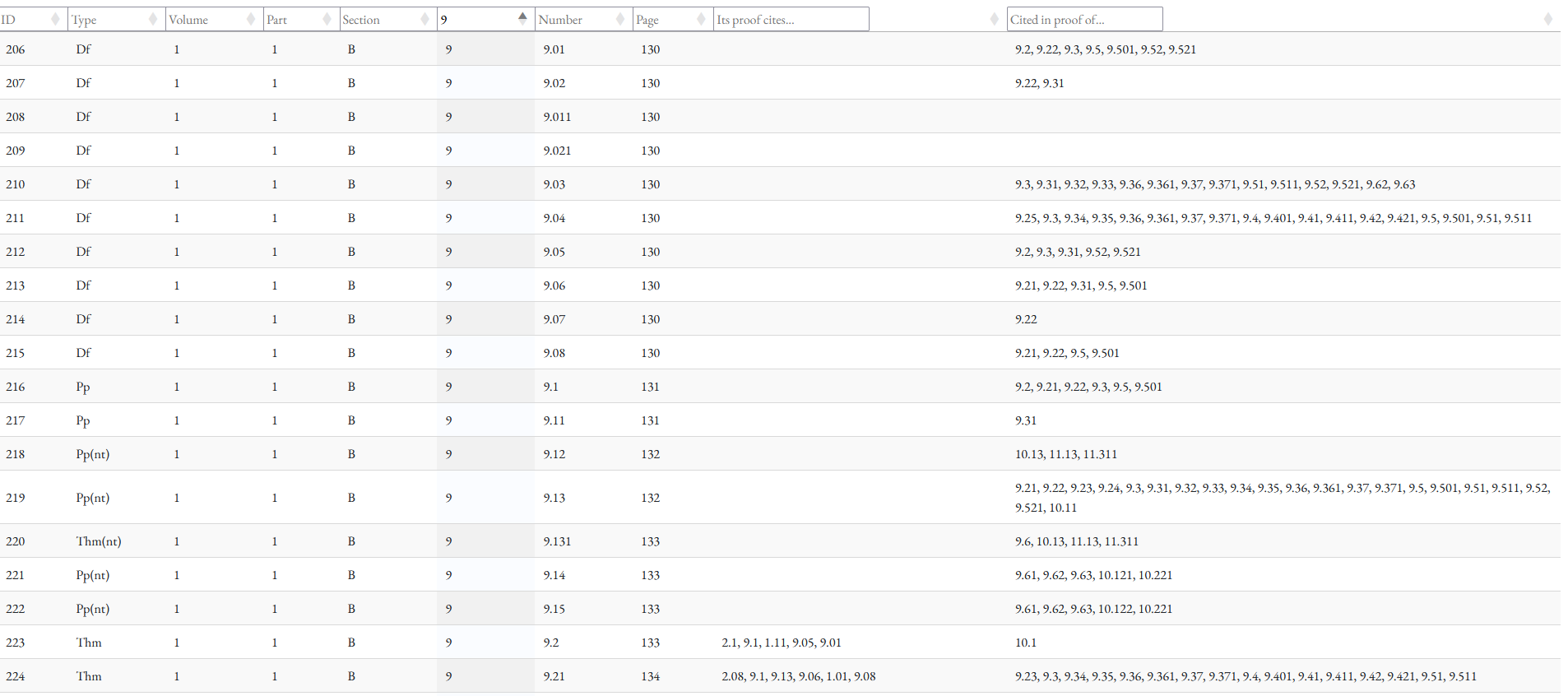
Then you can click “Export CSV” in the top left to get this:
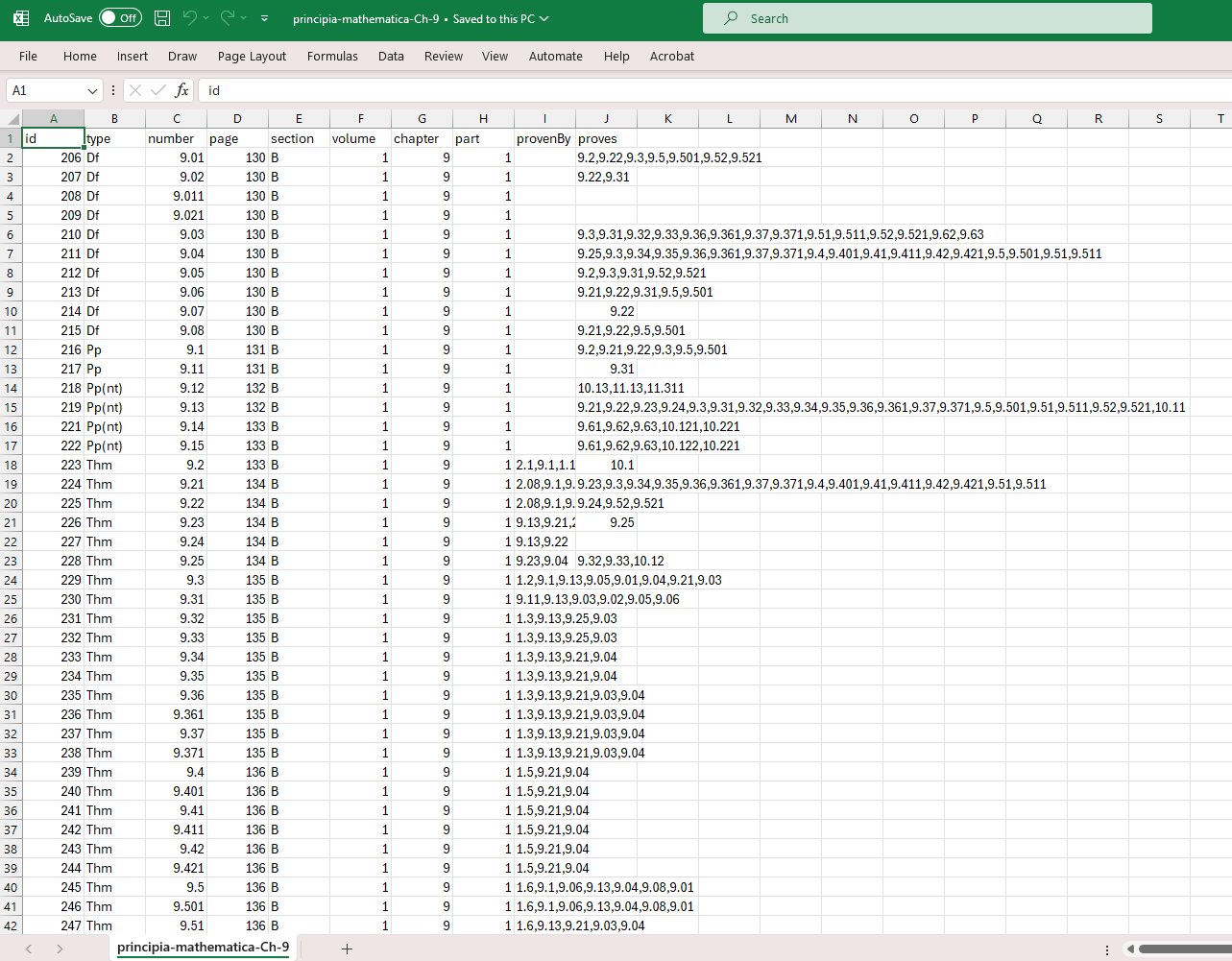
Second Edition Materials
Principia has been reprinted many times. The first edition, co-authored by Alfred North Whitehead and Bertrand Russell, was published in 1910-1913. The second edition, with a new introduction and three new appendices by Russell alone, was published in 1925-1927. The table on the PM-MATS includes data about starred numbers occurring in this second edition material, which are all contained in Appendix A (*8) and Appendix B (*89).
Readers only interested in first edition materials can filter out Chapters *8 and *89 in the table. Note that the table includes starred numbers from the second edition by default. In contrast, the global map of Principia excludes these starred numbers by default, but you can view the second edition global map with these two starred numbers included.
Second edition materials are included in the mini-maps networks. So, mini-maps of specific nodes within chapters will allow you to click to and from nodes within the second edition (when nodes from *8 and *89 in fact appear in the "Its Proof Cites..." and "Cited in Proof of..." columns) regardless of whether you navigate to a mini-map node from the default (landing page) global map (which is the first edition only) or the second edition global map just linked.
Principia Mathematica – Guide
Questions, Suggestions, or Comments?
Contact us using the project contact form. You can also submit an issue on the PM-MATS GitHub repository.